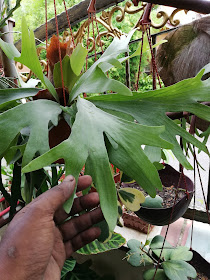Staghorn ferns (Platycerium) resemble the forked antlers of male deer or elk are highly sought after and also have high maintenance and care required compared to all other fern genes.
This particular type is an epiphytic ferns (only grows on trees) and thus should not grow using soil base medium. These are primarily native to Africa, Australia and Southeast Asia.
This particular type is an epiphytic ferns (only grows on trees) and thus should not grow using soil base medium. These are primarily native to Africa, Australia and Southeast Asia.
On 2009 (10 years ago)
These are the pictures I had taken from the Lake Garden's - Orchid Garden.
I'm pretty sure they are still there, these massive colony just manage to self-maintain itself without much care.
I think once these ferns had established itself, it doesn't need heavy maintenance or care except for occasional pruning of dead, dried foliage - even that, it's not so necessary.
These cascading fine long leaves are actually a different fern species. The name escapes my mind for now, I tried collecting it and installed it with sphagnum moss and cultivate it but it refuse to grow.
I think it is known as Ribbon Fern
This particular type of fern is divided by two gender - the male & and female foliage.
This cascading part is considered as female part of the ferns.
The crown part is considered the male part of the plant.
Both parts are necessary for the well being of the ferns and so do care not to accidentally damage or over-prune these portions as they are important for the ferns to sustain & grows fully.
On 2016, A friend had passed to me this fern - after reviving it - it started to regenerate well.
I had an earlier piece but it didn't well and started to loose its leaves and died.
I gave on it and still wondered if I can manage it
in my gloomy, dark, shaded garden.
It started to grow healthily without any blemish or burning of the leaves.
And new growth started to show - even-though its slow but as long as its doing well - I'm happy.
My concern was like there earlier one
Died without any warnings - hopefully this one grows well.
It was in bad shape, the leaves were dehydrated and burned.
However, it slowly recovered with constant care - with regular watering and with better humidity.
After a year (2017) It slowly recovered with more defined leaves.
It is a slow grower but eventually it gave beautiful foliages.
FEEDING:
The best is dried banana peels on weekly basis.
I use to put in fresh banana peels but it had attracted fruit flies and worse squirrels and tree shrews that came investigating due to the aroma and wreck apart the crown and frond of this ferns.
Best dry it over direct sun and use it for better options.
HUMIDITY:
This one does good with good humidity.
Placing this under a water body, like under a pond or below a water feature helps to regulate the humidity well and keep the greens well maintained.
SUNLIGHT:
It requires few hours of sunlight, at least indirect bright light.
Does not do well in total shade with heavy dark areas.
I had placed saplings and they all slowly rotted and died.
I think due to - too wet and it had caused root rot.
Airy & brightly lit areas helps it to regulate this whole fern ball for better overall growth.
New male foliage started to grow with better lighting and watering.
2018 (After 2 years of Care)
The plant finally manage to fully recover with new growth.
Finally, the male-part of the leaf is taking shape and taking cover over the root-ball.
Kind of nice to see how it envelops the whole thing and the 2 split-leaf formation on the cascading leaves is just amazing over the water pond.I had re-organized and did some landscape works for a friend.
This is her collection:
Platycerium Elissi
Platycerium Elissi
This is one of the grand stand ferns which I would consider falls in the collector's item category.
They are indeed highly sensitive and difficult to care types - a faulty mistake and it this can be fatal.
Regardless, with check and balance
Finding the best spot for them is needed to ensure their optimum growth and health.Here in the collection are:
Platycerium Veeitchii
Platycerium Elissi
Platycerium bifurcatum
Platycerium bifurcatum 'netherlands'
Platycerium Elissi
Platycerium Elissi
Platycerium bifurcatum
Platycerium bifurcatum
Platycerium Veeitchii
Platycerium Veeitchii
Platycerium bifurcatum 'netherlands'
Platycerium bifurcatum 'netherlands'
This particular one has very furry / hairy foliage.
The thing is, I won't recommend you to cultivate this one if you have high sinus problem.
Here are the types of platyceriums that makes a good collection.
Of course, this is the species types - there are many hybrids and cross mixed ones which are much grander looking.


























No comments:
Post a Comment
As for Anonymous commentors:
Please do write your name and place
(eg: John, UK)
That way, I know who you are and where you're from.
If you have any queries or questions - do put in the comment below or place your details in the Contact Form at the Bottom part of the Blog with your plant pictures.
I will try my best to give my thoughts on how to rectify the plant issues.
I really appreciate your thoughts and experiences concerning these matters. Thank you.
Regardless - I really appreciate your thoughts and experiences concerning these matters. Thank you.
And please no spamers, products, etc - they will be deleted as the comments are moderated.
If you have any queries that needs immediate attention - seek me out in Facebook/Messenger on (James David) message me and I will come back to you ASAP.
https://www.facebook.com/james.missier/